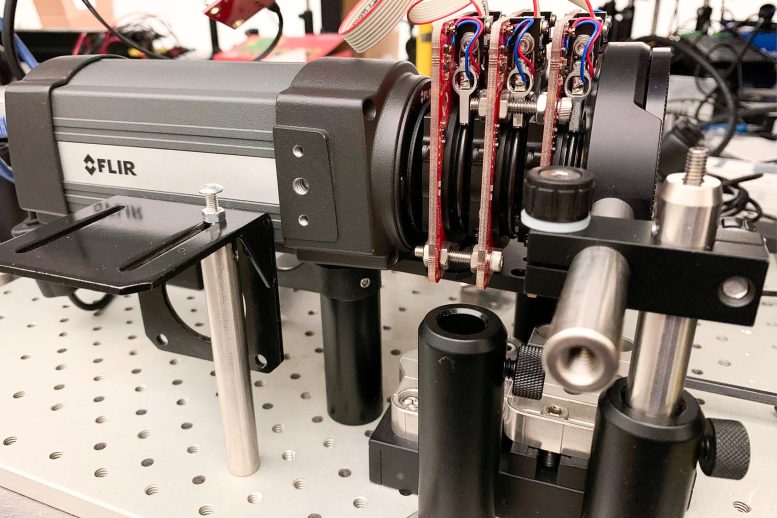
Researchers used a stack of spinning metasurface devices to capture spectral and polarization details of thermal radiation as well as the intensity information that is acquired with traditional thermal imaging. Credit: Xueji Wang, Purdue University
By gathering more intricate thermal data, this novel method could enhance autonomous navigation, material recognition, security, and other applications.
Researchers have created a novel technology utilizing meta-optical devices for thermal imaging. This method offers more detailed information about the objects being imaged, potentially expanding thermal imaging applications in autonomous navigation, security, thermography, medical imaging, and remote sensing.
“Our method overcomes the challenges of traditional spectral thermal imagers, which are often bulky and delicate due to their reliance on large filter wheels or interferometers,” said research team leader Zubin Jacob from Purdue University. “We combined meta-optical devices and cutting-edge computational imaging algorithms to create a system that is both compact and robust while also having a large field of view.”
In Optica, Optica Publishing Group’s journal for high-impact research, the authors describe their new spectro-polarimetric decomposition system, which uses a stack of spinning metasurfaces to break down thermal light into its spectral and polarimetric components. This allows the imaging system to capture the spectral and polarization details of thermal radiation in addition to the intensity information that is acquired with traditional thermal imaging.
The researchers showed that the new system can be used with a commercial thermal camera to successfully classify various materials, a task that is typically challenging for conventional thermal cameras. The method’s ability to distinguish temperature variations and identify materials based on spectro-polarimetric signatures could help boost safety and efficiency for a variety of applications, including autonomous navigation.

The stack of spinning metasurfaces breaks down thermal light into its spectral and polarimetric components. The researchers combined the metasurface stack with a traditional long-wave infrared camera and computational imaging algorithms to create a compact and robust spectral thermal imaging system. Credit:Xueji Wang, Purdue University
“Traditional autonomous navigation approaches rely heavily on RGB cameras, which struggle in challenging conditions like low light or bad weather,” said the paper’s first author Xueji Wang, a postdoctoral researcher at Purdue University. “When integrated with heat-assisted detection and ranging technology, our spectro-polarimetric thermal camera can provide vital information in these difficult scenarios, offering clearer images than RGB or conventional thermal cameras. Once we achieve real-time video capture, the technology could significantly enhance scene perception and overall safety.”
Doing more with a smaller imager
Spectro-polarimetric imaging in the long-wave infrared is crucial for applications such as night vision, machine vision, trace gas sensing, and thermography. However, today’s spectro-polarimetric long-wave infrared imagers are bulky and limited in spectral resolution and field of view.
To overcome these limitations the researchers turned to large-area metasurfaces — ultra-thin structured surfaces that can manipulate light in complex ways. After engineering spinning dispersive metasurfaces with tailored infrared responses, they developed a fabrication process that allowed these metasurfaces to be used to create large-area (2.5-cm diameter) spinning devices suitable for imaging applications. The resulting spinning stack measures less than 10 x 10 x 10 cm and can be used with a traditional infrared camera.
“Integrating these large-area meta-optical devices with computational imaging algorithms facilitated the efficient reconstruction of the thermal radiation spectrum,” said Wang. “This enabled a more compact, robust, and effective spectro-polarimetric thermal imaging system than was previously achievable.”
Classifying materials with thermal imaging
To evaluate their new system, the researchers spelled out “Purdue” using various materials and microstructures, each with unique spectro-polarimetric properties. Using the spectro-polarimetric information acquired with the system, they accurately distinguished the different materials and objects. They also demonstrated a three-fold increase in material classification SciTechDaily